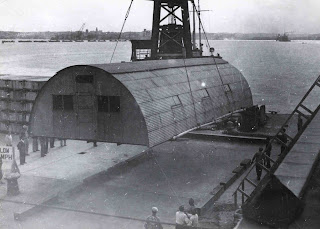The Pacyga reading basically was giving an insight as to the influence of the Daley (the 1st one) mayoral reign on Chicago. While doing some good things, like greatly improving the highway system (at the cost of underrepresented minorities) some things did get away from him.
 |
| Quonset- similar to some of the temporary housing the CHA enacted. |
The Prudential Building paved way for the development boom in the loop. The economy was on its way back up because of the war and with the excess of people there was a need for improved and increased housing. The Chicago Housing Authority was established which began phases of its housing for war workers, veterans, and low-income housing. It started with three and four story row houses and two story row houses. Then it went to townhouses, and then to the high-rises.
“Rows and rows of houses constructed during this period seemed like army barracks.”
The (racist) white people were voicing their concern with having African Americans living too close, which caused the beginning to the white flight and that “Chicago might have kept costs down and high-rises to a minimum if land on the outskirts of the city had been available.”
 |
| Robert Taylor Homes (Dan Ryan in upper right corner) |
Because of the development of the suburbs, Chicago was choked into the space it was currently occupying and that was all it could have.
The construction of the highways added to the racial divide on the southside. More specifically, the Dan Ryan.
Richard Wiser, in regards to the highway system, “its not at all well designed.”
I drive the Dan Ryan every time I go to school, and I agree with Wiser. The traffic is terrible and I can only imagine how stopped-up it was back when it first opened.
 |
| September 28, 1969 - CTA service begins in median strip of Dan Ryan Expressway. |
When it comes to the riots, Martin Luther King wanted to use Chicago as a northern state role model. Unfortunately the racism that was being shown towards the blacks was heartless, it reached a boiling point. “exploit, distort and ridicule [the African Americans.]" -Medium Cool. That’s where we can weave in the scenery and themes from Medium Cool.
Medium Cool
First off, I’m concerned that the 13/15 parts of Medium Cool on youtube was either edited in adding new or changed sounds and some of the sequences didn’t seem to fit at all. But that might the nature of the film. The further I got into it, the more I got annoyed. The riot scenes seemed ridiculously faked. One part was missing sound and the A.D.D. moments were hard to keep up with. But I feel I got the basics of it, with mentions to the riots of 1969, the depressing state of the school systems, the censorship of the media and the racism.
The Cahan reading was more about the physical shifting of the buildings. Either how they fell into disrepair, was degenerated into “lower” uses (beautiful storefront into laundry mat) or demolished despite its architectural beauty. The reading centers around Richard Nickel and his photography life as he documents buildings as they follow the changes with the city. He recorded what they looked like at the fraction of the moment as they slid into their own depression.
No comments:
Post a Comment